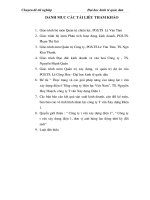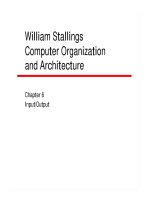slides trình diễn của COADP 7th edition william stallings computer organization and architecture 7th edition
Bạn đang xem bản rút gọn của tài liệu. Xem và tải ngay bản đầy đủ của tài liệu tại đây (513.53 KB, 74 trang )
William Stallings
Computer Organization
and Architecture
7th Edition
Chapter 18
Parallel Processing
Multiple Processor Organization
• Single instruction, single data stream SISD
• Single instruction, multiple data stream SIMD
• Multiple instruction, single data stream MISD
• Multiple instruction, multiple data streamMIMD
Single Instruction, Single Data Stream SISD
• Single processor
• Single instruction stream
• Data stored in single memory
• Uni-processor
Single Instruction, Multiple Data Stream
- SIMD
• Single machine instruction
• Controls simultaneous execution
• Number of processing elements
• Lockstep basis
• Each processing element has associated
data memory
• Each instruction executed on different set
of data by different processors
• Vector and array processors
Multiple Instruction, Single Data Stream
- MISD
• Sequence of data
• Transmitted to set of processors
• Each processor executes different
instruction sequence
• Never been implemented
Multiple Instruction, Multiple Data
Stream- MIMD
• Set of processors
• Simultaneously execute different
instruction sequences
• Different sets of data
• SMPs, clusters and NUMA systems
Taxonomy of Parallel Processor
Architectures
MIMD - Overview
• General purpose processors
• Each can process all instructions
necessary
• Further classified by method of processor
communication
Tightly Coupled - SMP
• Processors share memory
• Communicate via that shared memory
• Symmetric Multiprocessor (SMP)
—Share single memory or pool
—Shared bus to access memory
—Memory access time to given area of memory
is approximately the same for each processor
Tightly Coupled - NUMA
• Nonuniform memory access
• Access times to different regions of
memroy may differ
Loosely Coupled - Clusters
• Collection of independent uniprocessors or
SMPs
• Interconnected to form a cluster
• Communication via fixed path or network
connections
Parallel Organizations - SISD
Parallel Organizations - SIMD
Parallel Organizations - MIMD Shared
Memory
Parallel Organizations - MIMD
Distributed Memory
Symmetric Multiprocessors
• A stand alone computer with the following
characteristics
— Two or more similar processors of comparable capacity
— Processors share same memory and I/O
— Processors are connected by a bus or other internal
connection
— Memory access time is approximately the same for each
processor
— All processors share access to I/O
– Either through same channels or different channels giving
paths to same devices
— All processors can perform the same functions (hence
symmetric)
— System controlled by integrated operating system
– providing interaction between processors
– Interaction at job, task, file and data element levels
Multiprogramming and Multiprocessing
SMP Advantages
• Performance
—If some work can be done in parallel
• Availability
—Since all processors can perform the same
functions, failure of a single processor does
not halt the system
• Incremental growth
—User can enhance performance by adding
additional processors
• Scaling
—Vendors can offer range of products based on
number of processors
Block Diagram of Tightly Coupled
Multiprocessor
Organization Classification
• Time shared or common bus
• Multiport memory
• Central control unit
Time Shared Bus
• Simplest form
• Structure and interface similar to single
processor system
• Following features provided
—Addressing - distinguish modules on bus
—Arbitration - any module can be temporary
master
—Time sharing - if one module has the bus,
others must wait and may have to suspend
• Now have multiple processors as well as
multiple I/O modules
Symmetric Multiprocessor Organization
Time Share Bus - Advantages
• Simplicity
• Flexibility
• Reliability
Time Share Bus - Disadvantage
• Performance limited by bus cycle time
• Each processor should have local cache
—Reduce number of bus accesses
• Leads to problems with cache coherence
—Solved in hardware - see later
Operating System Issues
•
•
•
•
•
Simultaneous concurrent processes
Scheduling
Synchronization
Memory management
Reliability and fault tolerance









